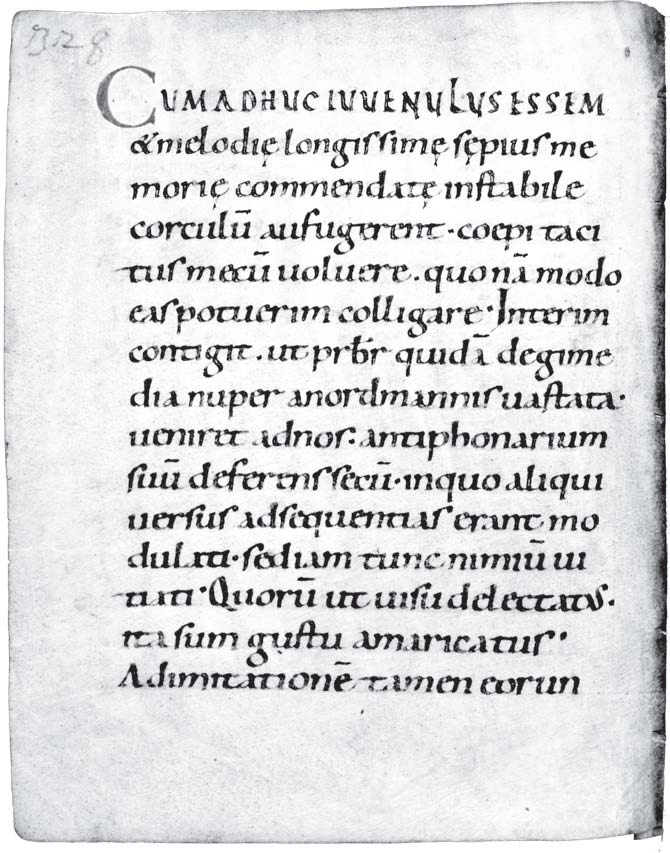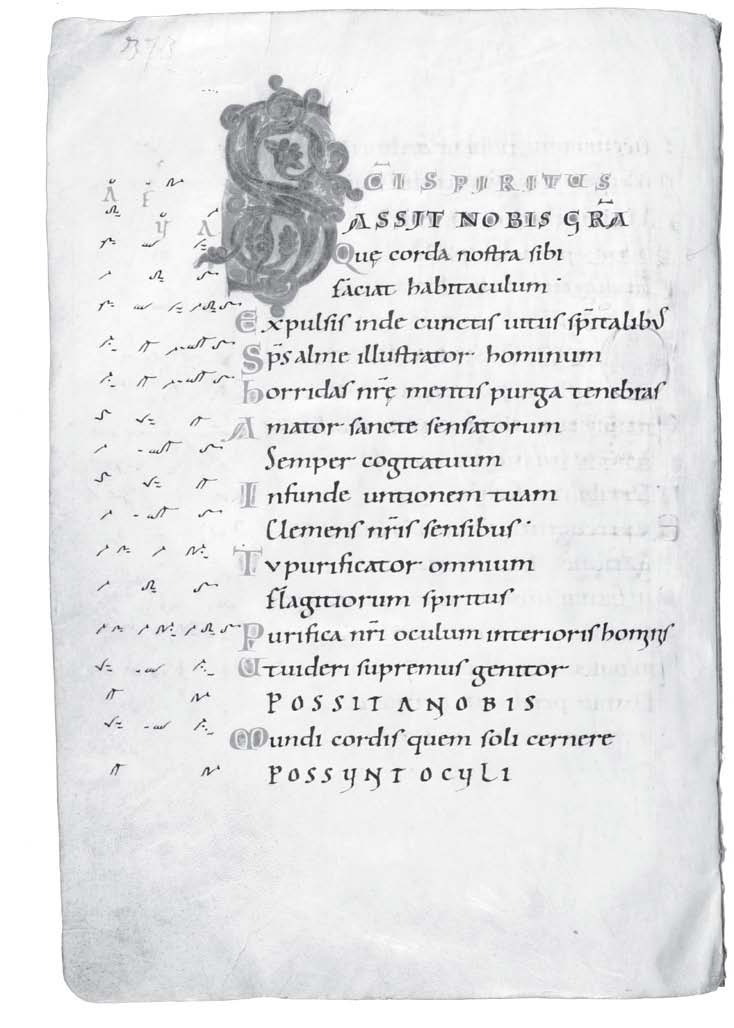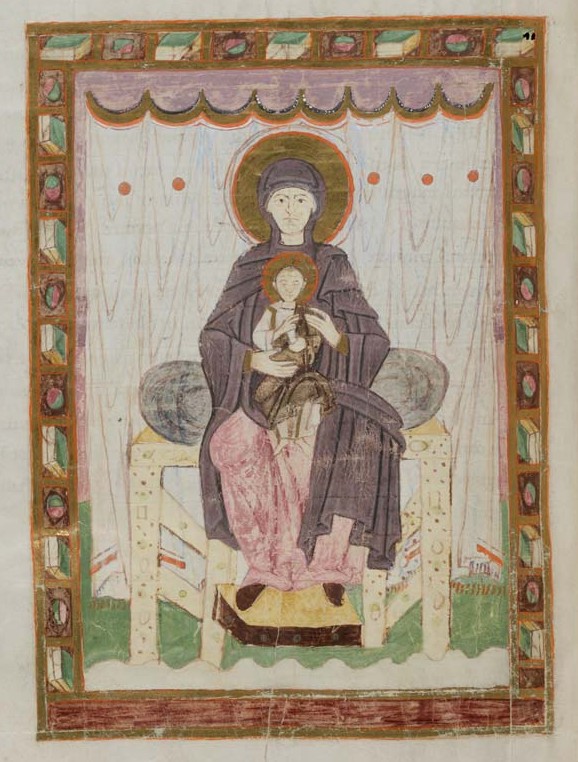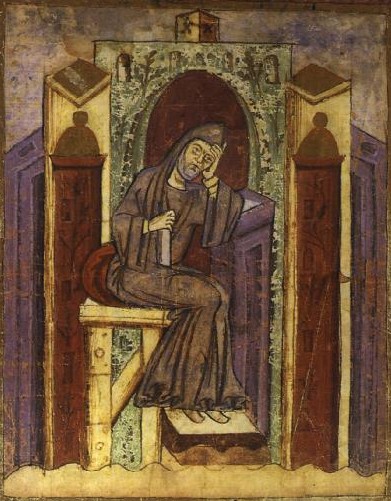Notker Balbulus (ca. 840-912) / Ordo Virtutum
Sequenzen, Tropen & Gregorianischer Choral aus dem Kloster St. Gallen

medieval.org
Christophorus CHR 77341
© 2010
1. Alleluia. Dies sanctificatus [1:48]
2. NOTKER von SANKT GALEN. Sequenz Natus ante saecula (Geburt des Herrn) [2:33]
3. Melodiemodell Dies sanctificatus [instrumental] [2:30]
4. Tropen Primus init Stephanus & En vice nos Stephani
zum Introitus Et enim sederunt principes (St. Stephanus) [3:23]
5. NOTKER. Sequenz Gaude Maria virgo (Gottesmutter Maria) [2:38]
6. Tropen Hodie clarissimam, Olim promissus, Forma speciosissimus [NOTKER ?]
& Olim quem vates zum Introitus Ecce advenit (Erscheinung des Herrn) [5:58]
7. Tropen Ex numero frequentium [NOTKER ?], Quasi quid incredibile
& Qui vobis terrigenis zum Introitus Viri Galilei (Christi Himmelfahrt) [4:36]
8. Tropus Consubstantialis patri zum Introitus Spiritus domini (Pfingsten) [2:48]
9. NOTKER. Sequenz Sancti spiritus assit nobis gratia (Pfingsten) [5:26]
10. NOTKER [?]: Melodiemodell Occidentana [instrumental] [2:34]
11. Einan kuning weiz ih (Ludwigslied, 882) [melodische Rekonstruktion: Stefan Morent] [9:45]
12. Melodiemodell Romana [instrumental] [2:07]
13. Introitus Gaudeamus omnes (Mariä Himmelfahrt) [2:35]
14. NOTKER. Sequenz Congaudent angelorum chori (Mariä Himmelfahrt) [2:50]
15. Melodiemodell Mater [instrumental] [3:10]
16. Alleluia. Iustus ut palma [2:40]
17. NOTKER. Sequenz Dilecte Deo Galle (St. Gallus) [2:13]

Ensemble Ordo virtutum für Musik des Mittelalters
Stefan Johannes Morent
Gesang:
Jörg Deutschewitz (Solo: 6, 16)
Hubert Mayer (Solo: 7, 9, 14)
Stefan Johannes Morent (Solo: 11)
Jörg Rieger (Solo: 1, 6)
Daniel Schreiber (Solo: 4, 7, 9, 14)
Alexander Yudenkov (Solo: 4, 8, 9, 13)
Susanne Ansorg, Fiedel
Stefan Johannes Morent, Harfe, Portativ
 Unser Dank gilt der Schlossverwaltung Staatliche Schlösser und Gärten Bebenhausen, besonders Herrn Alexander
Unser Dank gilt der Schlossverwaltung Staatliche Schlösser und Gärten Bebenhausen, besonders Herrn Alexander
Brass, und der Katholischen Kirchengemeinde Heilig Kreuz Binningen/CH für die Unterstützung und Hilfe an den
Aufnahmeorten.
Instrumente:
Harfe nach romanischen Vorbildern von Reiner Thurau, Wiesbaden 1998
Portativ mit Kupferpfeifen nach Theophilus von Louis Huivenaar, Amsterdam 1980/2005
Fiedel in D: Thilo Viehrig, Kaulsdorf 1998, Fiedel in E: Richard Earle, Basel 1997
Verwendete Handschriften:
A-Wn 1609, CH-E 121, CH-E 366, CH-E 610, CH-SGs 342, CH-SGs 359, CH-SGs 375
CH-SGs 376, CH-SGs 378, CH-SGs 380, CH-SGs 381, CH-SGs 382, CH-SGs 484, CH-SGs 546
CH-SGv 317, D-B 40078, D-B 40608, D-BAs lit. 5, D-Mu 2° 156, F-Pn 10587
F-VAL 150, I-BV 39, I-Rc 1741, I-SCAcc VII 7, NL-Uu 417
Alle Übertragungen aus den Handschriften und Übersetzungen: Stefan Johannes Morent
Bildnachweis (Handschriften aus der Stiftsbibliothek St. Gallen):
Digipack innen: „Pfingstsequenz Sancti spiritus“, Cod. Sang. 546, fol. 112r
Booklet cover: „Miniatur zur Weihnachtssequenz Natus ante secula“, Cod. Sang. 376, S. 319
S. 8. : „Vorrede zu Notkers Liber Hymnorum“, Cod. Sang. 381, S. 328
S. 13: „Pfingstsequenz Sancti spiritus“, Cod. Sang. 376, S. 373
S. 17: „Gallus-Sequenz Dilecte Deo Galle“, Cod. Sang. 376, S. 397
Eine Koproduktion des
Südwestrundfunks Studio Tübingen und der Stiftsbibliothek Sankt Gallen
Excutive producer: Dr. Anette Sidhu-Ingenhoff (SWR Landesstudio
Tübingen), Prof. Dr. Ernst Tremp (Stiftsbibliothek Sankt Gallen)
Recording: 06.-09.04.2010, ehem. Zisterzienserkloster Bebenhausen (D) & 07.06.2010, Kirche Heilig Kreuz Binningen (CH)
Recording engineer & editing: Malgorzata Albinska-Frank
Sound Engineer: Jörg Heinkel
Editor (MusiContact) & layout: Joachim Berenbold
Cover: “Notker Balbulus” (Biblioteka Jagiellonska, Krakow, Cod. theol. lat. qu. 11, fol. 144r)
“Natus ante saecula” (Stiftsbibliothek Sankt Gallen, Cod. Sang. 376, S. 320)
Translations: English · Lindsay Chalmers-Gerbracht / Français · Sylvie Coquillat
Ⓟ 2010 SWR
© 2010 MusiContact GmbH Heidelberg, Germany
Herstellung: Sonopress, Gütersloh - Made in Germany

The
intensive cultivation of the so-called Gregorian chants and their
textual and/or melodic extensions during the Early Middle Ages in the
Monastery of St Gall is eloquently testified by the numerous manuscripts
which originated there and are still preserved in the Abbey Library of
St Gall. The treasure of the St Gall musical manuscripts which only make
up a small part of the entire collection of surviving manuscripts is
unique for its volume, unity and intact condition. With the aid of these
manuscripts, we are able to research into and reconstruct the entire
history of literary-musical culture of the St Gall Monastery right back
to its beginnings with the reception of the cantilena romana –
the chants of the Roman Catholic Church – their adoption and adaptation
to local practices and their commentarial extension in poetry and music
in the Early Middle Ages via the already retrospective and partially
glorifying reception of the monastic house tradition in the eleventh
century and right down to the much later recollection following the
abandonment of traditions in the sixteenth century.
The Abbey
Library provides a home for manuscripts which are vital not only for
specialised research into the liturgical music at St Gall, but also for
general research into the Mediaeval period: this collection includes
examples of early repertoire relating to Gregorian chants such as the
socalled St Gall Cantatorium (around 920, CH-SGs 359), and for
the younger categories trope and sequence, the St Gall
tropers-sequentiaries dating back to the period between the tenth and
twelfth centuries.
Although the formation and reception of
Gregorian chant in St Gall has been somewhat obscured by the anonymous
darkness of historical annals or has been associated with figures of
legend, evidence does however exist for certain individual poets and
musicians who can be unambiguously linked to the newer types of chant:
for example, Notker the Stammerer (Balbulus, ca. 840-912) for the Sequence, Tuotilo (ca. 850 – ca. 913) for the Trope and Ratpert (ca. 855 – after 902) for the Verse (strophic songs for liturgical purposes or the acclamation of rulers).
Notker, who named himself “stammerer” (balbus or balbulus) or “toothless” (edentulus)
not merely as a gesture of humility but also because of his speech
impediment, chiefly wrote sacred poetry in addition to his history of
the deeds of Charlemagne (Gesta Karoli Magni) and a life of the
Irish monk Gallus, the founder of the monastery. A letter to his fellow
brother Lantbertus in which he explains to him the function of the
additional signs – the so-called Romanian letters – which are utilised
in manuscripts of the chants, confirms his familiarity with this
material. According to the tradition of St Gall, the monk Romanus who
was originally from Rome had actually taught the authentic form of
Gregorian chant in the monastery of St Gall.
This recording
focuses on the works of Notker; the CD presents a number of the
best-known and most perfect creations of the great poet-musician from St
Gall. The greatest emphasis is given to the sequence form with which
Notker’s name is particularly linked: a supplementary entry in the
necrology of the Gallus monastery on the occasion of his death on 6
April 912 reads: Qui sequentias composuit. In the preface to his personal compilation of his own composed sequences dedicated to Liutward of Vercelli, the so-called Liber hymnorum,
he describes how external inspiration caused him to come upon the
artistic principle governing sequences: poetic texts should be adapted
to pre-existing melodies so that the smallest melodic units (singulae motus cantilenae) would exactly correspond to individual syllables in the harmonious unity of melody and inflexion (singulas syllabas debent habere, versus modulaminis apti).
In addition, two lines of text are assigned to the same melodic section
and complement one another in a similar manner to psalms. There is
however no mention of the origin of these melodies without texts.
Although they have their place within the liturgy following the
Alleluia, they rarely pick up on a specific Alleluia from the mass (for
example the melodic pattern Dies sanctificatus for the Christmas sequence Natus ante saecula at the beginning of the Alleluia for Christmas Day Dies sanctificatus),
and are otherwise only linked to the Alleluia through the common
characteristic of a broadly-based melody without text; these could have
originated in external, non-ecclesiastical areas due to their as yet
partially unexplained names in the manuscripts (such as Mater or Cignea),
or could even have been composed by Notker himself according to the
later chronistic tradition of the Gallus monastery. Their autonomy is
indicated by their notation in the St Gall manuscripts in the margin to
the parallel running text: in CH-SGs 484 even without any text apart
from the initial syllables A [ l l ] E [ l ] U [ i ] A which denote an
affinity to the Alleluia. In view of this autonomy of the sequence
melodies, some of these pieces are presented in this recording in
instrumental or vocalise versions. The oldest surviving fragmentary
versions of the Liber Hymnorum are considered to have originated
during the lifetime of Notker; the earliest complete sequentiaries from
St Gall were compiled in the second quarter of the tenth century.
 Five
sequences for major feasts during the ecclesiastical year have been
selected for this recording from the sequences attributed to Notker by
Wolfram von den Steinen on the basis of stylistic research which is
still considered valid in our time: Natus ante saecula (Christmas), Gaude Maria virgo (Blessed Mother Mary), Sancte spiritus (Whitsuntide), Congaudent angelorum chori (Feast of the Assumption) and Dilecte Deo Galle for the Feast of the founder of the monastery.
Five
sequences for major feasts during the ecclesiastical year have been
selected for this recording from the sequences attributed to Notker by
Wolfram von den Steinen on the basis of stylistic research which is
still considered valid in our time: Natus ante saecula (Christmas), Gaude Maria virgo (Blessed Mother Mary), Sancte spiritus (Whitsuntide), Congaudent angelorum chori (Feast of the Assumption) and Dilecte Deo Galle for the Feast of the founder of the monastery.
Notker’s
authorship regarding the area of tropes is substantially more
problematic: no comparable complete collection of these works has
survived. The tropes included in this recording which either function as
an introduction to the referential chants of the Introits or provide an
interlinear textual and/or musical extension to and commentary on these
sections can for the most part be attributed with a certain degree of
accuracy either to Notker (for example Forma speciosissimus and Ex numero frequentium) or one of his circle, but without doubt to the traditions of St Gall.
One
specific problem is universally confronted in the performance of
Notker’s works: the melodies in the St Gall manuscripts are notated
throughout in neumes without staves which prevent an exact
interpretation of the pitches of these compositions. This missing
information was retained in St Gall in its parallel existing oral
tradition which was fixed in neumes, but was unfortunately lost before
the melodies could be notated on lines. When Father Cuontz from St Gall
attempted to record Notker’s sequences with their corresponding melodies
on lines during the efforts to have Notker canonised in the sixteenth
century, he found that the house tradition was no longer intact and was
forced to search beyond the confines of the monastery for corresponding
manuscripts still in existence. We must be grateful for the fact that
Notker’s sequences had a wide distribution as this has guaranteed the
survival of legible melodic versions of his works right up to the
present day. It must however be kept in mind that a substantial part of
these manuscripts originated in areas with a substantial geographical
and cultural distance to St Gall which could mean that the original
versions have undergone a certain degree of modification.
For
this reason, the reconstructions of the melodic versions of both
sequences and tropes for this recording have been compiled with the aid
of a large number of manuscripts from a wide variety of provenances. As
details of the St Gall neume notation also offer valuable clues for the
reconstruction of pitches and performance interpretation, these
manuscripts have provided guidelines permitting the closest possible
approximation to the traditions of St Gall regarding both transcription
and interpretation. Ultimately, this can be nothing more than a
“virtual” version, as we will never know precisely how Notker’s
sequences were performed in St Gall in the ninth century. This does not
merely apply to Notker’s new compositions, but also to the chants which
are however indispensable to illustrate the close link between the
referential chants and their extensions and distinguish the new from the
old. And Notker himself also participates in this conflicting polarity
between inherited tradition and his own creations: in the picture of the
author which was formerly included in Codex 376, he is depicted as a
contemplative, meditative poet-musician who yet is simultaneously linked
with the traditions of Pope Gregory the Great through the depiction of
the Holy Spirit in the form of a dove which provides the melodies for
the chants.
In certain passages in our interpretation of the
sequences, we utilise the earliest form of Western polyphony which has
also been documented as existing as early as the ninth century. These
early forms of organum, as documented in the musicological text Musica Enchiriadis
(“Handbook of Music”), were also seen as a special decoration of
particular chants or sequences: for example, two voices sing in parallel
fourths or recite extensively on bourdon notes. Although the St Gall
Library does not own a copy of the Musica Enchiriadis, it can be assumed from the wide dispersion of this polyphonic technique that it was also known in the monastery of St Gall.
Raids
and pillaging by Normans and Hungarians presented a constant threat
during Notker’s lifetime and beyond. A monk who had fled to St. Gall
from the monastery of Jumièges which had been destroyed by the Normans
brought with him an antiphonar which is said to have inspired Notker to
produce his sequences.
A battle between the king of the West
Franks, Ludwig III, and the Normans (Battle of Saucourten-Vimeu in 881)
is described in the Ludwigslied [Song of Ludwig] in the Old High German
language. This song in the style of the bardic heroic epic depicts the
great valour and strength of King Ludwig. The text without music has
been preserved in a manuscript from Valenciennes which was first
discovered by Dom Jean Mabillon in St. Amand and subsequently
rediscovered by A.-H. Hoffmann von Fallersleben. The reconstruction of
the melody and performance technique is based on observations of the
continuing traditions of oral epics.
Our CD thereby records a tonal image of the significance and influence of the Abbey of St Gall down through the centuries.
Stefan Johannes Morent
Further literature: Stiftsbibliothek Sankt Gallen Codices 484 & 381, commented and produced in facsimile by Wulf Arlt & Susan Rankin, Winterthur 1996.
The St. Gall manuscripts are now accessible online at www.cesg.unifr.ch.



 Unser Dank gilt der Schlossverwaltung Staatliche Schlösser und Gärten Bebenhausen, besonders Herrn Alexander
Unser Dank gilt der Schlossverwaltung Staatliche Schlösser und Gärten Bebenhausen, besonders Herrn Alexander
 Five
sequences for major feasts during the ecclesiastical year have been
selected for this recording from the sequences attributed to Notker by
Wolfram von den Steinen on the basis of stylistic research which is
still considered valid in our time: Natus ante saecula (Christmas), Gaude Maria virgo (Blessed Mother Mary), Sancte spiritus (Whitsuntide), Congaudent angelorum chori (Feast of the Assumption) and Dilecte Deo Galle for the Feast of the founder of the monastery.
Five
sequences for major feasts during the ecclesiastical year have been
selected for this recording from the sequences attributed to Notker by
Wolfram von den Steinen on the basis of stylistic research which is
still considered valid in our time: Natus ante saecula (Christmas), Gaude Maria virgo (Blessed Mother Mary), Sancte spiritus (Whitsuntide), Congaudent angelorum chori (Feast of the Assumption) and Dilecte Deo Galle for the Feast of the founder of the monastery.